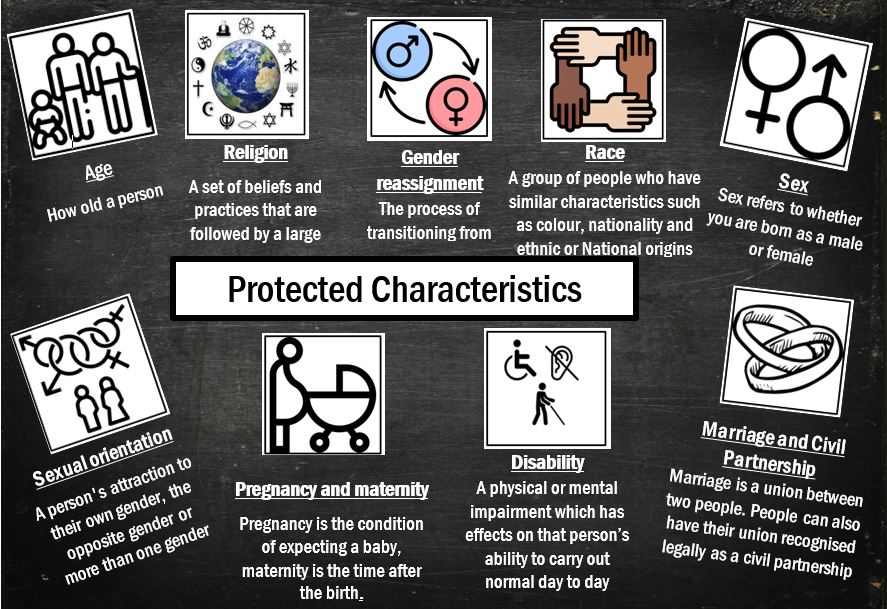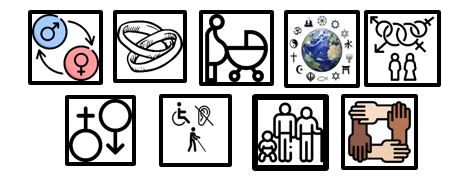Promoting protected characteristics at Meadowbank
At Meadowbank we work to ensure that our children know and understand that:
- Everyone is welcome at Meadowbank
- Everyone is different
- We celebrate our differences
- We are all equal in our differences
The Equality Act became law in 2010. It covers everyone in Britain and protects people from discrimination, harassment and victimisation. Everyone in Britain is protected. This is because the Equality Act protects people against discrimination because of the protected characteristics that we all have. Under the Equality Act, there are nine Protected Characteristics:
- Age
- Disability
- Gender reassignment
- Race
- Religion or belief
- Marriage or civil partnership
- Sex
- Sexual orientation
- Pregnancy and maternity
Under the Equality Act you are protected from discrimination:
- When you are in the workplace
- When you use public services like healthcare or education
- When you use businesses and other organisations that provide services and goods (like shops, restaurants, and cinemas)
- When you use transport
- When you join a club or association.
- When you have contact with public bodies like your local council or government departments
The 9 Protected Characteristics are actively promoted in school through:
- Our school ethos statements, SDP, and SEF
- Our school core values and expectations
- Our schools Positive Relationships Policy
- Conscious role modelling by all adults in the school community
- Active engagement and communication with parents and carers
- Assemblies
- The promotion of British Values throughout school
- Promoting articulation by building appropriate language and a coherent vocabulary
- Developing a love of reading through a range of authors and genres
- Personal, Social, Health and Economic education (PSHE) sessions
- Religious Education (RE) lessons
- Sporting, Art and Cultural Events
- Pupil Voice
- Educational visits
- Real-life learning outside the classroom
- Guest speakers
- Developing links with local, national and international communities
- Extra-curricular activities, after-school clubs, charity work and work within the local community
Embedding Protected Characteristics into the whole ethos of Meadowbank promotes:
- Self-esteem, self-knowledge and self-confidence
- Respect for democracy and support for participation in the democratic process
- Acceptance of responsibility for their own behaviour
- Respect for their own and other cultures
- Understanding of how they can contribute positively to school and home life and to the lives of those living and working in the locality and further afield
- An understanding of Equality, Human Rights and Protected Characteristics
- An understanding of how citizens can influence decision-making through the democratic process
- An appreciation that living under the rule of law protects individual citizens and is essential for their wellbeing and safety
- An understanding that the freedom to choose and hold other faiths and beliefs is protected in law
- An acceptance that other people having different faiths or beliefs to oneself (or having none) should be accepted and tolerated, and should not be the cause of prejudicial or discriminatory behaviour
- An understanding of the importance of identifying and combating discrimination
How do we use our PSHE scheme to support children’s understanding and the teaching of Protected Characteristics?
The protected characteristics are taught in a way that is progressive and developmental in a pupil-centred way. Our inclusive approach starts with children in Nursery and Reception and continues to develop through each key stage up to year 6.
Children recognise each of the protected characteristics through the use of key symbols which are used across the curriculum throughout school. For each symbol there is a definition that help to supports children’s understanding and articulation of each of the 9 protected characteristics. Symbols are as follows:
Sessions are taught in a safe, open and inclusive learning environment based on trusting relationships between all members of the class, adults and students alike. Children are encouraged to discuss the ideas and learning in their lessons at home, but to show their classmates the respect and privacy that they would want in return.
‘Celebrating Difference’ which is taught in Autumn 2 across school, is the most pertinent of units for teaching about the protected characteristics, as it focuses on similarities and differences and teaches about diversity, such as disability, racism, gender, family composition, friendships, and conflict. Children learn to accept everyone’s right to ‘difference’, exploring the concept of ‘normal’. Bullying – what it is and what it isn’t, including cyber and homophobic bullying. ‘Relationships’ which is taught in the Summer 1, has a wide focus, looking at diverse topics such as families, friendships, equality in relationships, and love and loss – all of which can help to deliver the vital messages behind the Equality Act. A vital part of this is about safeguarding and keeping children safe; this links to cyber safety and social networking, as well as attraction and assertiveness; children learn how to deal with conflict, their own strengths and self-esteem.
The grid below offers some suggestions as to how particular PSHE Jigsaw lessons can be used to support the teaching of protected characteristics. Note that this list is not exhaustive as there are numerous other lessons that teach about equality.
|
Protected characteristic |
What this refers to |
Links to our PSHE scheme |
|
Age |
Where this is referred to, it refers to a person belonging to a particular age (for example, 32-yearolds) or range of ages (for example, 18- to 30-yearolds). |
Celebrating Difference Age 8-9 -Judging by Appearance Age 8-9- Understanding Influences Age 10-11- Understanding Difference Ages 10-11- Power Struggles |
|
Gender reassignment |
The process of transitioning from one gender to another. |
Celebrating Difference Age 6-7 - Gender Diversity NB: there is no direct reference to transgender or the concept of transitioning in this lesson. Ages 10-11 -Understanding difference NB. In Jigsaw the focus is on accepting all people as unique individuals, not on transitioning itself. |
|
Marriage or Civil partnership |
Marriage is no longer restricted to a union between a man and a woman but now includes a marriage between a same-sex couple. Same-sex couples can also have their relationships legally recognised as ‘civil partnerships’. Civil partners must not be treated less favourably than married couples. |
Celebrating Difference Ages 7-8 - Families Age 10-11 - Understanding Difference
Relationships Age 5-6- Families Ages 6-7- Families |
|
Being pregnant or on maternity leave |
Pregnancy is the condition of being pregnant or expecting a baby. Maternity refers to the period after the birth, and is linked to maternity leave in the employment context. In the non-work context, protection against maternity discrimination is for 26 weeks after giving birth, and this includes treating a woman unfavourably because she is breastfeeding. |
Celebrating Difference Ages 3-4/4-5 - Families Ages 7-8- Families Age 10-11 -Understanding Difference |
|
Disability |
A person has a disability if she or he has a physical or mental impairment which has a substantial and long-term adverse effect on that person’s ability to carry out normal day-to-day activities |
Celebrating Difference Ages 10-11 - Celebrating difference Age 6-7 - Standing up for Myself and others Age 8-9 - Judging by Appearances Age 8-9 - Celebrating Differences: How We Look Age 10-11 - Understanding Difference |
|
Race including colour, nationality, ethnic or national origin |
Refers to the protected characteristic of Race. It refers to a group of people defined by their race, colour, and nationality (including citizenship) ethnic or national origins. |
Celebrating Difference Ages 9-10 - Different Cultures Ages 9-10 - Racism Age 7-8 - Families Age 10-11 - Understanding Difference |
|
Religion, belief or lack of religion/belief |
Religion has the meaning usually given to it but belief includes religious and philosophical beliefs including lack of belief (such as Atheism). Generally, a belief should affect your life choices or the way you live for it to be included in the definition. |
Celebrating Difference Ages 9-10 - Different Cultures Age 10-11 -Understanding Difference |
|
Sex |
A man or a woman
|
Celebrating Difference Ages 6-7 Pieces-Boys and Girls Age 8-9 - Judging by Appearances Age 10-11 -Understanding Difference Changing Me Age 7-8 - Family Stereotypes |
|
Sexual orientation |
Whether a person’s sexual attraction is towards their own sex, the opposite sex or to both sexes |
Celebrating Difference Age 6-7 - Standing up for Myself and others Age 7-8 - Families Age 9-10 - Rumours and Name Calling Age 9-10 -: Types of Bullying Age 10 – -Understanding Difference Relationships Age 8- 9 Girlfriends and Boyfriends Changing Me Ages 10-11 Piece 4: Boyfriends and girlfriends |




.png)
.png)
